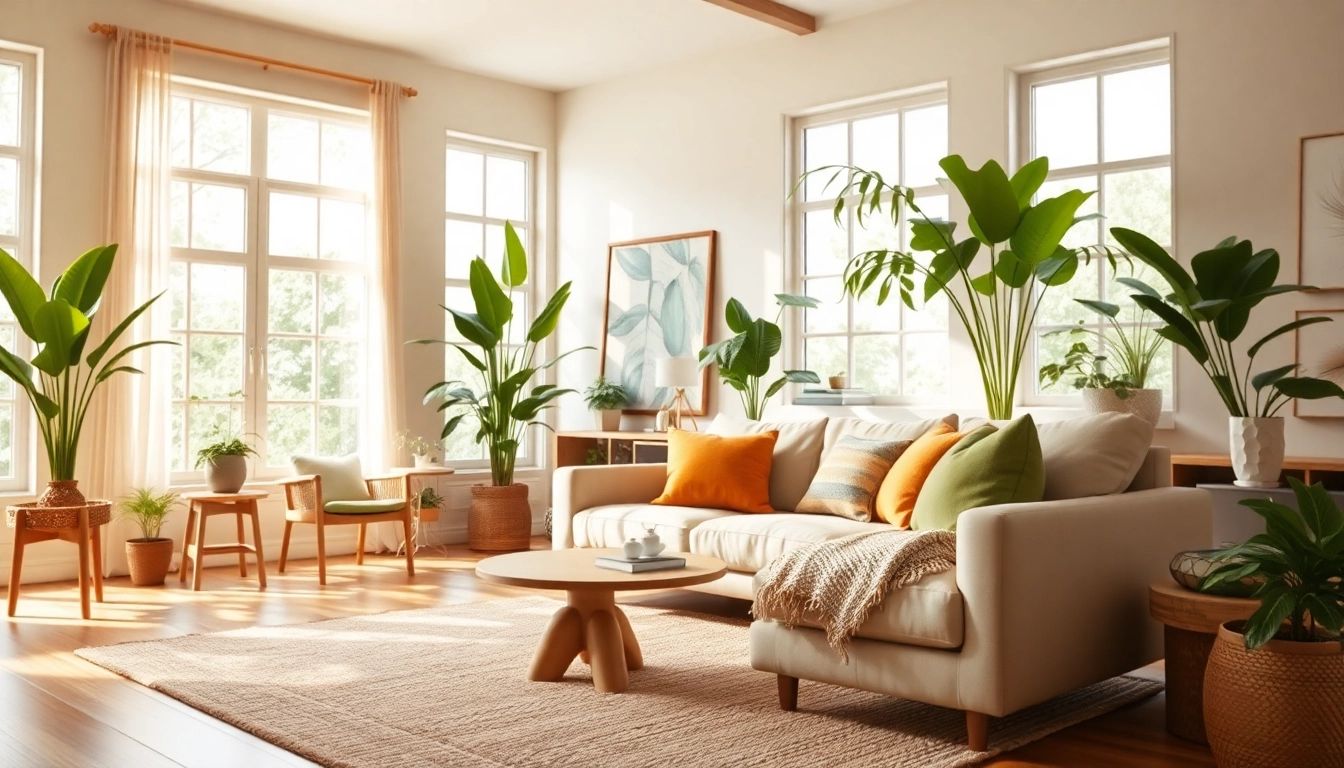Understanding Creative Living
Creative living reflects a lifestyle that embraces innovation, individuality, and imagination. It encourages individuals to express their uniqueness through their living environments, fostering spaces that inspire creativity and comfort. Whether you’re transforming a single room or an entire home, the essence of Creative living is in the details, which speaks volumes about personal style and values.
What is Creative Living?
At its core, creative living is about designing spaces that resonate with one’s personality and aspirations. It moves beyond mere aesthetics; it incorporates functionality, personal narratives, and sustainability into design choices. Whether through bold color selections, eclectic furnishings, or innovative space use, creative living champions a lifestyle where imagination guides home design.
The Importance of Space in Creative Living
Space is a fundamental aspect of creative living. A well-thought-out environment encourages individuals to be more productive, relaxed, and inspired. Key considerations include:
- Layout and Flow: The arrangement of furniture should facilitate easy movement while promoting social interaction. Consider open layouts for communal areas and cozy nooks for relaxation.
- Personal Space: Incorporating areas that allow for solitude can enhance creativity, enabling your mind to wander and explore new ideas.
- Multi-functional Spaces: Using furniture that serves multiple purposes maximizes space, especially in smaller homes, where flexibility is priceless.
Benefits of Adopting Creative Living Principles
Embracing creative living yields various advantages, including:
- Enhanced Well-being: Creative spaces can reduce stress and promote mental health through the calming effects of personalized aesthetics and mindful design.
- Increased Productivity: Environments that inspire can lead to greater creativity and efficiency in work and personal projects.
- Stronger Identity: Reflecting personal tastes in living spaces can foster a sense of belonging and pride, reinforcing individual identity.
Designing for Creative Living
Essential Elements of Creative Living Spaces
A creative living space incorporates crucial design elements that merge aesthetics with functionality:
- Color Palette: The colors chosen for a space impact mood and energy. A mix of vibrant and muted tones can create a dynamic yet harmonious environment.
- Texture Variety: Using diverse materials—such as wood, metal, glass, and textiles—adds depth to a space and caters to different sensory experiences.
- Lighting: Natural and artificial lighting setups should enhance the functionality of spaces while creating transformations based on time of day.
Choosing Colors and Textures for Creative Living
Color and texture are imperative for setting the tone of your living area. Each color evokes specific emotions—blues for calmness, yellows for happiness, and bold reds for energy. Here’s how to thoughtfully approach color and texture combinations:
- Accent Walls: An accent wall painted in a striking color can serve as a focal point, making spaces feel dynamic.
- Textural Contrasts: Combine smooth surfaces with rough textures to add complexity and intrigue.
- Seasonal Changes: Use interchangeable textiles—such as throw pillows, rugs, and curtains—to refresh the aesthetic according to seasons.
Integrating Art into Creative Living Designs
Art plays a vital role in enriching creative living. It’s not just a decorative element; it tells a story and personalizes spaces:
- Creating Focal Points: Large pieces of art can serve as conversation starters and can create visual interest in a room.
- Gallery Walls: A curated collection of artworks or photographs can showcase personal history and style.
- DIY Art Projects: Personal creations, from paintings to crafty decor, can tailor aesthetics to one’s taste and foster connection.
Incorporating Nature into Creative Living
Benefits of Biophilic Design in Creative Living
Biophilic design emphasizes the connection between humans and nature, promoting well-being through natural elements. The implementation of this concept produces benefits:
- Improved Air Quality: Incorporating plants can purify air, improving indoor environments.
- Enhanced Mood: Natural elements foster tranquility and reduce stress.
- Increased Productivity: Exposure to nature boosts focus and overall performance in household tasks.
Best Indoor Plants for Creative Living Spaces
When choosing plants for creative living spaces, consider low maintenance options that thrive indoors:
- Snake Plant: Known for its air-purifying qualities, it requires minimal light and care.
- Pothos: A versatile, trailing plant that thrives in various conditions and is easy to propagate.
- Peace Lily: This plant not only blooms beautifully but also improves air quality by filtering household toxins.
Creating Outdoor Extensions for Creative Living
Outdoor spaces serve as extensions of your home. Designing these areas can enhance the living experience:
- Functional Furniture: Invest in durable, comfortable outdoor furniture to encourage relaxation and social gatherings.
- Outdoor Art: Integrate sculptures or decorative elements that withstand the elements while adding character.
- Gardens and Greenery: Designing a garden can be both a therapeutic undertaking and a beautiful visual asset.
DIY Tips for Creative Living Projects
Simple DIY Projects to Enhance Creative Living
Engaging in DIY projects can be rewarding, both personally and aesthetically. Here are several straightforward yet impactful ideas:
- Furniture Makeover: A fresh coat of paint or new upholstery on existing furniture can transform its appearance and extend its life.
- Homemade Decor: Craft personalized art pieces or decorative objects using materials at hand for a unique touch.
- Organizing Solutions: Create stylish storage solutions, such as decorative boxes or shelving, to declutter spaces while enhancing style.
Upcycling Ideas for a Sustainable Creative Living
Upcycling promotes sustainability while allowing creativity to flourish. Consider the following projects:
- Furniture Repurposing: Turn an old ladder into a bookshelf or use wooden crates as storage solutions, contributing to an eco-friendly lifestyle.
- Textile Recycling: Transform old linens into new throws, cushion covers, or textile wall art, reducing waste and enhancing your home.
- Reimagined Garden Decor: Convert discarded glass jars or bottles into stylish planters or candle holders for outdoor spaces.
Personalizing Your Creative Living Space
Personalization infuses your space with identity. Here are ways to achieve that:
- Family Memories: Display family photos or heirlooms to reinforce a sense of history and continuity.
- Custom Color Schemes: Experiment with mixtures of personal favorite colors to harmonize them with the design theme.
- Thematic Decor: Choose a theme—such as coastal, bohemian, or modern—that resonates with you and use it to guide decor choices.
Future Trends in Creative Living
Smart Home Innovations for Creative Living
The integration of technology in creative living continues to evolve, with smart home solutions enhancing efficiency and comfort through automation:
- Automated Lighting: Smart lighting systems can adjust based on time of day, optimizing environments for activities and moods.
- Smart Thermostats: These help manage energy consumption for heating and cooling, creating more sustainable living environments.
- Integrated Audio Systems: Enhances the atmosphere in creative spaces by providing personalized soundtracks for relaxation or productivity.
Colors and Styles to Watch in Creative Living Design
Staying ahead of color and style trends can keep living spaces feeling fresh and modern. Look for trends such as:
- Earthy Tones: Natural colors inspire warmth and connection to nature, trending towards sustainable living.
- Maximalism: A departure from minimalistic design, maximalism embraces bold patterns and vibrant colors, allowing vibrant personality expression.
- Retro Elements: Nostalgic designs are making a comeback, utilizing vintage elements to create unique, character-filled spaces.
Community Trends and the Collaborative Spirit of Creative Living
Communal living spaces reflect a trend towards shared experiences and collaboration, affecting how we think about design:
- Co-housing Initiatives: Shared living arrangements can foster community while providing affordability and collaboration in resource utilization.
- Workshops and Skill Sharing: Developing community programs that teach skills, such as art or gardening, can bolster community identity and collective creativity.
- Social Responsibility: Community-focused designs encourage sustainability practices and inclusive spaces that reflect shared values.



